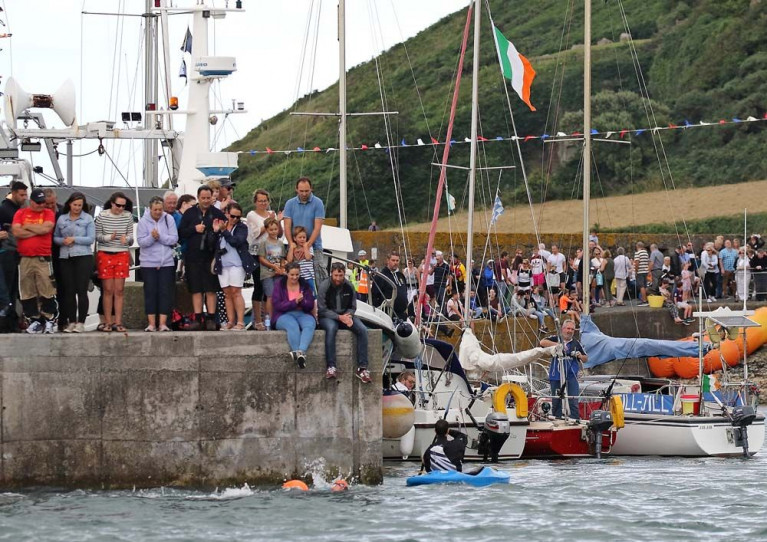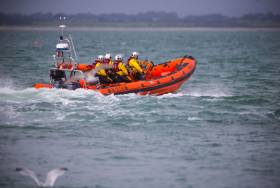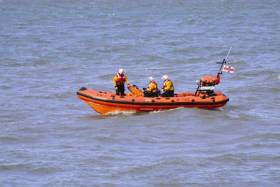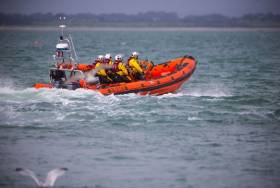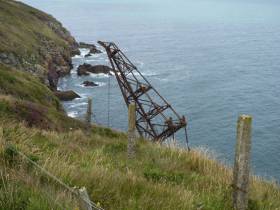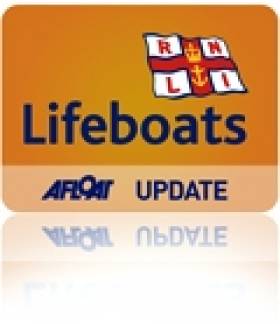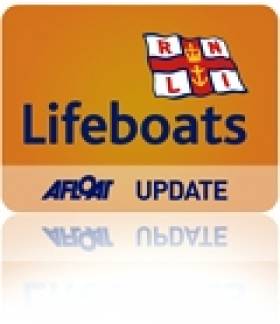Displaying items by tag: Helvick Head
Helvick Head RNLI came to the aid of a fisherman on Saturday afternoon last (2 October) after his 21ft open deck boat broke down at Mine Head.
The volunteer crew were requested to launch their inshore lifeboat by the Irish Coast Guard at 2.26pm following a report that the vessel had suffered intermittent engine failure at Mine Head, off the Old Parish coastline in the Deise Gaeltacht region.
The lifeboat helmed by Alan Kelly and with crew members Paudie Walsh, Shane Walsh and Simon O’Hare onboard, launched immediately and made its way to the scene.
There was a Force 5-6 west to north-west wind blowing at the time.
Arriving on scene at 2.46pm, the lifeboat crew assessed the situation before deciding to tow the vessel back to the nearest safe port at Helvick Head Pier where they arrived at 3.20pm.
Speaking following the call out, Helvick Head RNLI Helm Alan Kelly said: ‘The casualty did the right thing by calling for help when he realised he was in difficulty. The winds were too fresh for him to return to the harbour without assistance.
‘We would remind anyone planning a trip to sea to always go prepared. Always wear a lifejacket and always carry a means of communication. Should you get into trouble or see someone else in difficulty, dial 999 or 112 and ask for the Coast Guard.’
Helvick Head RNLI Aids Four People After 14ft Pleasure Boat Breaks Down Near Dungarvan Bay
Helvick Head RNLI came to the aid of four people on Monday evening (6 September) after their 14ft open pleasure boat broke down at Cunnigar Point.
The volunteer crew were requested to launch their inshore lifeboat at 7.19 pm following a request from the Irish Coast Guard to assess the situation where the boat with two men and two women onboard, had suffered engine failure at Cunnigar Point, a 5km sand spit that juts across from An Rinn to Dungarvan Bay.
The lifeboat helmed by Alan Kelly and with crew members, Paudie Walsh, Richard Haynes and Joe Foley onboard, launched immediately and made its way to the scene.
Weather conditions at the time were bright and sunny with a flat calm sea and an easterly Force 1 wind.
On arrival, the lifeboat crew first ensured that all onboard were safe and well before assessing the situation and deciding to tow the vessel to the nearest safe port at Ballynagaul.
Speaking following the call out, Sean Walsh, Helvick Head RNLI Deputy Launching Authority said: ‘We would like to commend the group who had taken the necessary safety precautions for their trip. They were all wearing their lifejackets and were at anchor when the lifeboat arrived.’
Volunteer lifeboat crew from Helvick Head RNLI in Waterford, rescued three kayakers stranded on rocks at Kilmurrin Cove yesterday afternoon (Wednesday 28 July) when a sudden squall capsized one of the kayaks and the group were forced onto the rocks as conditions rapidly deteriorated. The three kayakers were brought to safety when the lifeboat crew carried out a challenging manoeuvre to bring the lifeboat close to the rocks in the choppy waters and the group were helped onto the lifeboat by lifeboat crew and the winchman from Rescue 117.
The alarm was raised at 12.18 pm and Helvick RNLI were joined on the scene by Rescue 117, Bunmahon Coast Guard and Bunmahon Community Rescue Boat. The kayakers got into difficulty when conditions turned from mild to challenging quite quickly. Squalls and horizontal rain saw one kayaker capsize and the group were pushed over to rocks at Kilmurrin Cove. Taking refuge on the sharp rocks in the worsening conditions, a rescue operation was immediately launched. The winchman from Rescue 117 was able to descend from the helicopter onto the rocks and stay with the group as the lifeboat crew made the difficult approach to the rocks.
With no shoreline or safe landing spot, the lifeboat Helm performed a veering down manoeuvre which brought the lifeboat close to the rocks. A lifeboat crewmember swam to the rocks to assist the Rescue 117 winchman with the transfer of the casualties onto the lifeboat. In a highly precise and closely timed exercise, which relied on the crew taking note of the movement of the lifeboat into and away from the rocks, the three casualties were helped onboard the lifeboat and brought to the safety of the shore, where they were met by members of Bunmahon Coast Guard.
Commenting on the callout Helvick Head RNLI crewmember Joe Foley said, ‘“This was a great outcome in some challenging conditions. The wind picked up very quickly out there and the group were right to seek safety on the rocks. We were glad to see that they were all wearing buoyancy aids and had not sustained any injuries other than some scratches. The veering down manoeuvre which we carried out is something that we practice regularly in training, but every scenario is different, and it is challenging when dealing with multiple casualties and a moving lifeboat in choppy water. We have a great group of search and rescue agencies around here and we all work well together.”
The RNLI advises to always wear the proper safety equipment for your activity and always bring a means of calling for help.
This is the fourth callout for Helvick RNLI in the last ten days.
RNLI Helvick Swim Cancelled
The 2020 RNLI Helvick Sponsored Swim in County Waterford which was scheduled for Sunday, September 13, has been cancelled due to the revised Covid-19 restrictions.
It would have been the 26th year of the event which was a major fundraiser for the RNLI and social occasion in Waterford.
Helvick Head Lifeboat Rescues Fishing Vessel Crew In Midnight Callout
#RNLI - Helvick Head RNLI had its first callout for 2018 in the early hours of Saturday morning (20 January) when the crew of a fishing vessel reported engine difficulty.
Pagers sounded at 1.50am and volunteer crew Brian O’Rourke, Joe Foley, Shane Walsh and Cathal Reilly launched the inshore lifeboat Robert Armstrong within minutes.
The lifeboat travelled the eight miles to the vessel and a tow was quickly set up. Sea conditions were described as moderate at the time.
The vessel was then towed back to Helvick Harbour, docking safely at just after 5am.
Commenting on the rescue, Helvick Head RNLI lifeboat operations manager John Condon said: “It was great to see the excellent reaction to the call by all the members of the crew.
“Given the time at which the pagers went off, it was fantastic to see the response by all – not only those who went to sea but also by the others who assisted on the shore.”
Helvick Head Lifeboat Crew Rescue Man From Water After Pier Car Crash
#RNLI - Helvick Head RNLI rescued a man who got into difficulty in the water at Helvick Pier early this morning (Sunday 11 September).
The volunteer lifeboat crew was requested to launch their inshore lifeboat at 7.12am following a report of a potential tragedy at Helvick Pier on the Co Waterford headland.
On arriving at the car park, the crew observed a crashed car. The lifeboat took to the water immediately and within seconds shore helpers spotted a casualty in the water.
Once on scene with the casualty, crew members Shane Breathnach and Dónal Ó Faoláin entered the water to assist.
The casualty, who was struggling to stay afloat, was helped into the lifeboat where he was treated for hyperthermia by helm Shay Young and crew member Cathal Reilly.
The man was then returned to Helvick Lifeboat Station where he was cared for until the ambulance arrived and he was transferred to hospital.
"It was a close call this morning and we would like to commend local fishermen Barty Whelan and Richard Tobin who were active on the shore in raising the alarm, spotting the casualty and remaining on site," said Young following the callout.
"Once on scene, it took all four of us aboard the lifeboat to bring the man in and do what was necessary. We would like to wish the casualty a full recovery following his ordeal."
Helvick Head Lifeboat Joins Rescue Of Kayakers In Dungarvan Bay
#RNLI - Three kayakers who got into difficulty in Dungarvan Bay on Sunday evening (7 August) were assisted by the volunteer crew of Helvick Head RNLI.
The inshore lifeboat Robert Armstrong launched just after 6.30pm following a report that three people in kayaks were struggling in strong winds and currents in the Ballyvoile area of Dungarvan Bay.
One kayaker had made his way ashore but was stuck on rocks and was in need of medical assistance. He was airlifted by the Irish Coast Guard helicopter to Waterford Regional Hospital.
A second woman was helped from her kayak by the lifeboat crew and brought ashore at Clonea Beach close by. The third person was successful in reaching the shore.
The lifeboat, helmed by John Condon and with crew members Shane Walsh and Joe Foley onboard, later returned to the scene to recover a kayak from the rocks.
"Strong winds and the tide made it difficult for the casualties to get ashore and they were struggling," said Condon after the callout, "so the lifeboat was essential in ensuring the safe recovery of the second kayaker as well as in assisting the helicopter. We would like to wish all three kayakers well after their ordeal."
The incident came on the same day that a group of 12 kayakers was rescued in Dublin Bay after failing to heed the small craft warning in place due to forecast high winds, as previously reported on Afloat.ie.
Man Dies While Diving Off Waterford Coast
#Diving - A man has died after getting into difficulty while diving off Ardmore in Co Waterford yesterday afternoon (Sunday 12 June).
Youghal RNLI's volunteer lifeboat crew were tasked to the incident between Goat Island and Ram Head near Ardmore, Co Waterford before 4.30pm.
On arrival they found a man in the water who they recovered onto the lifeboat, and immediately administered casualty care.
Working with Helvick Head RNLI, who were also on scene, the casualty was winched onto the Irish Coast Guard helicopter Rescue 117 and brought to Waterford University Hospital, where he was later pronounced dead, as the Irish Examiner reports.
A spokesperson for Helvick Head RNLI that a second diver who had been with the deceased had managed to swim to shore to raise the alarm, allowing for a swift emergency response.
Commenting on the callout, Youghal RNLI lifeboat operations manager Fergus Hopkins said: "This was a difficult callout for everyone concerned and our thoughts are with the family of the man who was taken from the water this afternoon."
'Duck Race' For Helvick Head RNLI Hailed A Success
#RNLI - The Duck Race in aid of the Helvick Head RNLI lifeboat station on Saturday 11 April 11th was a "spectacular success", according to race co-ordinator RoseAnn Foley.
As part of the Cois Cé celebrations during West Waterford Festival of Food, the 600 little yellow ducks entered the water from Devonshire Bridge in Dungarvan at 1.15pm with a lively commentary from Jenny Beresford and Sean Breathnach as they floated down Davitt’s Quay.
First prize in the Duck Race went to RNLI crew Liam Harty. Second was a photo finish between Séamus Kiersey from Ardmore and Tomás de Faoite ón Rinn, while third went to Tom Considine from Dungarvan and fourth went to Catherine Downey also from An Rinn.
Later, all the ducks were collected from the mud and were washed and put into storage until their next race.
And they weren't the only attraction on the day, with a free lifejacket clinic and sea safety check conducted by Austin Flynn also proving popular.
"We are very grateful to the public, Dungarvan Harbour Sailing Club, the kayakers, SGC and all our sponsors, West Waterford Festival of Food and the media for their enormous support," said Foley.
Naming Ceremony For Helvick Head RNLI's New Lifeboat Next Saturday
#RNLI - The naming ceremony and service of dedication of Helvick Head RNLI’s new Atlantic 85 lifeboat Robert Armstrong will take place at the lifeboat station on Helvick Pier on the south side of Dungarvan Bay at 11am on Saturday 30 August.
The new lifeboat was funded through a legacy from the late Robert Armstrong and will be named in his memory. Robert passed away on 9 November 2009 and the lifeboat will be named by his niece Judi Fleming during the ceremony.
Robert Armstrong was born in 1936 and loved sailing, fishing and boats. He crewed in the English Channel and the North Sea. Bob’s main home was Blackheath but he was most relaxed at his holiday home in Potter Heigham on the Norfolk Broads, where he moored his own boat.
Commenting ahead of the ceremony, his niece Judi said: "Robert’s aunt Alice and her brother Charles were the donors of Alice and Charles, Helvick Head RNLI’s previous lifeboat. Robert attended the ceremony back in 2000 and he was given an RNLI jacket which he wore proudly.
"It is great that something is left in his name of such importance as a lifeboat; saving people’s lives. We as a family are very proud of Bob and what he has done. He would have been 78 on 31 August."
Several members of the Armstrong family will travel from the UK to attend the naming ceremony and service of dedication.
The new lifeboat is an Atlantic 85, built at a cost of €255,000, and has a number of improvements from the Atlantic 75, Helvick Head’s former lifeboat, including a faster top speed of 35 knots, radar, provision for a fourth crewmember and more space for survivors.
It can operate safely in daylight in up to Force 7 conditions and at night up to Force 6. It also allows lifeboat crews to respond even faster in emergencies.
Helvick Head RNLI fundraising chairman Oliver Clancy will MC the ceremony and Chaplin Fr Conor Kelly and the Very Rev Dean Draper will lead the service of dedication.
Lifeboat operations manager Ian Walsh will accept the lifeboat on behalf of Helvick Head lifeboat station.
Local dignitaries, guests and RNLI volunteers from other lifeboat stations on the coast and the general public will also be in attendance. Cór Fear na nDéise, the local men’s choir and Pax, Cárthach and Macdara Ó Faoláin will perform at the event in addition to Dónal Clancy, who will sing the RNLI anthem 'Home from The Sea', which was sung by his dad the late Liam Clancy as the Alice & Charles was launched in 2000.
All are welcome to attend this event, but are asked to park their cars on the main road, as access to Helvick Pier from the Erin’s Hope monument will be controlled in the interest of public safety. There will be extra parking in Murray’s field near the pub on the main road in Helvick.
Following the ceremony and with conditions permitting, the Robert Armstrong lifeboat will be launched.


























